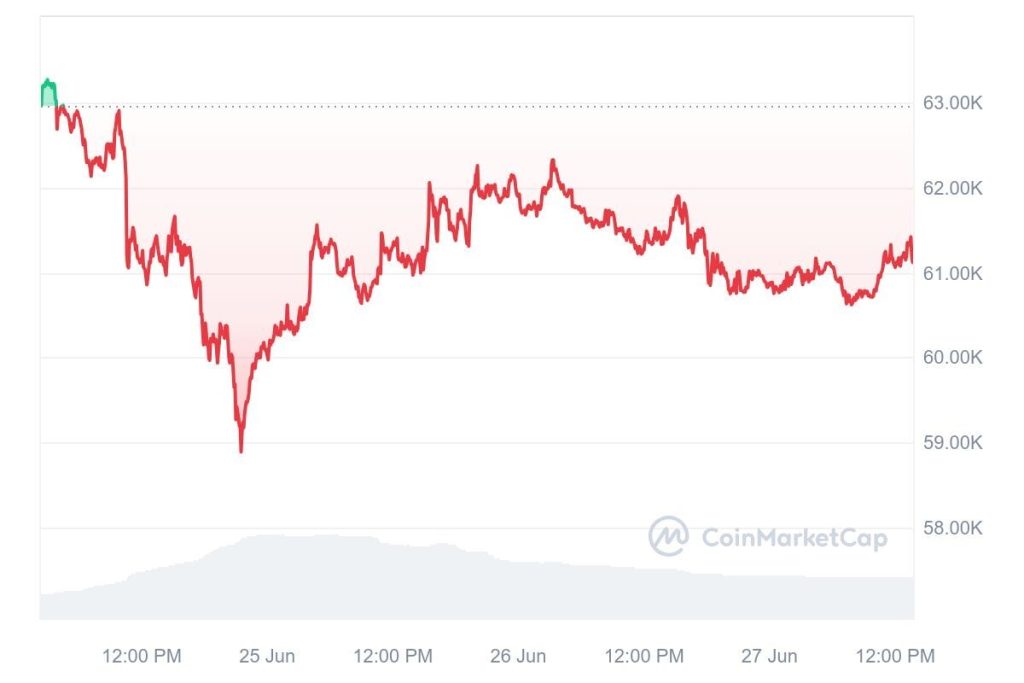
Unexpected Bitcoin has been transferred from a Satoshi bitcoin wallet from the early days of the cryptocurrency.
On June 27, a bitcoin wallet address from the Satoshi era that had lain dormant for 14 years reportedly sent 50 BTC, or roughly $3.05 million, to the Binance exchange.
The wallet is thought to be owned by a Bitcoin miner who most likely received the 50 BTC in 2010 as a mining reward.
Mystery Surrounds Satoshi Era Bitcoin Wallet Transfer
On-chain analytics firm Lookonchain revealed the Bitcoin wallet’s origins. It’s linked to a miner who received 50 BTC as a mining reward on July 14, 2010, just months after the Bitcoin network launched.
A miner wallet woke up after being dormant for 14 years and deposited 50 $BTC($3.05M) to #Binance 7 hours ago.
— Lookonchain (@lookonchain) June 27, 2024
The miner earned 50 $BTC from mining on July 14, 2010.
Address:
1PDTDwpgRPdQaCcp3Th6zaMASgcCcm3Jcm pic.twitter.com/toKmBfbUne
In 2010, the value of one Bitcoin was only $0.003. It took until February 2011 to surpass this price, which reached $30 by June of that same year.
At $61,110, Bitcoin has now dropped 16.99% from its all-time high of over $73,750 reached in mid-March 2024.

Developed between 2009 and 2011, in the early stages of Bitcoin, Satoshi bitcoin wallets are significant historically.
During this time, the mysterious person who created Bitcoin, Satoshi Nakamoto, continued to be involved in the cryptocurrency community.
Any transfer of funds from the wallets is significant because of their historical significance and the small number of transactions that took place during that time.
Satoshi Bitcoin wallets were created during Bitcoin’s early years, specifically between 2009 and 2011, when its pseudonymous creator, Satoshi Nakamoto, was still active in the cryptocurrency community.
The historical significance of these wallets and the comparatively low volume of transactions that occurred during that time frame make any transfer of funds from them noteworthy.
A personal computer could be used by anyone to mine Bitcoin in 2010, with a 50 BTC reward. This accessibility contrasts sharply with the conditions that exist today for Bitcoin mining.
Since then, the block reward has been cut four times, to a meager 3.125 BTC. The deflationary model of Bitcoin depends heavily on these halvings, which take place approximately every four years.
This latest transfer from a bitcoin wallet owned by Satoshi is not an isolated instance. It becomes one more example of a dormant wallet coming to life.
Something similar happened in March. On April 25, 2010, a miner who had not used their wallet for 14 years sent 50 BTC to Coinbase.
A miner wallet woke up after being dormant for nearly 14 years and deposited 50 $BTC($3.67M) to #Coinbase.
— Lookonchain (@lookonchain) March 14, 2024
The miner earned 50 $BTC from mining on April 25, 2010, and has been holding it to this day.https://t.co/6kwWwrXLiK pic.twitter.com/KsEuWJfuiZ
In the bitcoin community, the reactivation of these wallets frequently sparks curiosity and conjecture.
Many are interested in the reasons behind these actions, whether they indicate a shift in the dynamics of the market or are just the result of a long-time holder ultimately choosing to sell their holdings.
Bitcoin Whale Wake Alongside Satoshi Era Wallet Addresses
Bitcoin Whales are people or organizations with enormous holdings of Bitcoin that have the ability to impact the market due to their volume of trading and holdings.
After lying dormant for ten years, two such Whale wallets suddenly came to life on May 12, 2024, transferring a total of 1,000 BTC.
When Bitcoin was trading at $124 on September 12 and 13, 2013, each wallet was first given 500 BTC, or $62K.
On May 6, a noteworthy incident occurred when a Bitcoin Whale transferred $43.893 million in Bitcoin to two wallet addresses.
When the Whale first received the Bitcoin on January 12, 2014, it was trading at $917. Since then, it has been dormant for more than a decade.















Leave a Reply